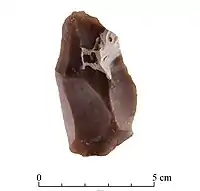
The Nesher Ramla Homo group are an extinct population of archaic humans who lived during the Middle Pleistocene in what is now modern-day Israel. In 2010, evidence of a tool industry had been discovered during a year of archaeological excavations at the Nesher Ramla site. In 2021, the first Nesher Ramla Homo individual was identified from remains discovered during further excavations.
Taxonomy

The Nesher Ramla site was discovered in a karst depression following quarrying from a nearby cement factory. The site was excavated by archaeologists between 2010–2011 and yielded artefacts in archaeological deposits from the Middle Paleolithic that were reported by D. Friesem, Y. Zaidner, and R. Shahack-Gross.[2] Evidence of a lithic industry was found during the excavation. The artefacts from the site contained Levallois tools and lithic cores.[3]
Later excavations led by anthropologist Israel Hershkovitz in 2021 led to the discovery of five pieces of a braincase and a nearly-complete lower jaw. The remains were dated to 140–120 kya, during the Middle Pleistocene.
Hershkovitz speculated that the specimen might be categorised as among the last survivors of a population that would contribute to the Neanderthals and East Asian Homo.[4] Philip Rightmire of Harvard University did not agree with the findings, believing instead that properly, the skull should be categorised as among early Neanderthals. Rightmire also discussed the possibility of a Neanderthal population having migrated to the area from Europe.[5] Yoel Rak of Tel Aviv University stated that the mandible bore characteristics typical of a Neanderthal, and that the specimen itself should be classified as a Neanderthal.[6]
Artefacts

More than 6,000 stone tools were excavated in the fossil-bearing sediment of the site. The Nesher Ramla Homo population mastered stone tool production technologies previously known among Neanderthals and Homo sapiens. The team led by Zaidner interpreted the presence of this tool industry as evidence of cultural interactions between Nesher Ramla populations and Homo sapiens populations.[1]
See also
- Denisovan – Asian archaic human
- Homo longi – Archaic human from China, 146,000 BP
- Homo luzonensis – Archaic human from Luzon, Philippines
- Homo naledi – South African archaic human species
- Homo floresiensis – Archaic human from Flores, Indonesia
References
- 1 2 Zaidner, Yossi; Centi, Laura; Prévost, Marion; Mercier, Norbert; Falguères, Christophe; Guérin, Gilles; Valladas, Hélène; Richard, Maïlys; Galy, Asmodée; Pécheyran, Christophe; Tombret, Olivier (25 June 2021). "Middle Pleistocene Homo behavior and culture at 140,000 to 120,000 years ago and interactions with Homo sapiens". Science. 372 (6549): 1429–1433. doi:10.1126/science.abh3020. ISSN 0036-8075. OCLC 1644869. S2CID 235628141.
- ↑ Friesem, David E.; Zaidner, Yossi; Shahack-Gross, Ruth (8 May 2014). "Formation processes and combustion features at the lower layers of the Middle Palaeolithic open-air site of Nesher Ramla, Israel". Quaternary International. 331: 128–138. Bibcode:2014QuInt.331..128F. doi:10.1016/j.quaint.2013.03.023. ISSN 1873-4553. OCLC 67285037.
- ↑ Zaidner, Yossi; Centi, Laura; Prevost, Marion; Shemer, Maayan; Varoner, Oz (2018), Nishiaki, Yoshihiro; Akazawa, Takeru (eds.), "An Open-Air Site at Nesher Ramla, Israel, and New Insights into Levantine Middle Paleolithic Technology and Site Use", The Middle and Upper Paleolithic Archeology of the Levant and Beyond, Singapore: Springer Singapore, pp. 11–33, doi:10.1007/978-981-10-6826-3_2, ISBN 978-981-10-6825-6, OCLC 1203992920
- ↑ Hershkovitz, Israel; May, Hila; Sarig, Rachel; Pokhojaev, Ariel; Grimaud-Hervé, Dominique; Bruner, Emiliano; Fornai, Cinzia; Quam, Rolf; Arsuaga, Juan Luis; Krenn, Viktoria A.; Martinón-Torres, Maria (25 June 2021). "A Middle Pleistocene Homo from Nesher Ramla, Israel". Science. 372 (6549): 1424–1428. doi:10.1126/science.abh3169. ISSN 0036-8075. OCLC 1644869. S2CID 235628111.
- ↑ Jones, Nicola (25 June 2021). "Mysterious skull fossils expand human family tree — but questions remain". Nature. 595 (7865): 20. doi:10.1038/d41586-021-01738-w. ISSN 0028-0836. OCLC 759932692. PMID 34172962.
- ↑ Marrom, Assaf; Rak, Yoel (2 December 2021). "Comment on "A Middle Pleistocene Homo from Nesher Ramla, Israel"". Science. 374 (6572): eabl4336. doi:10.1126/science.abl4336. ISSN 0036-8075. PMID 34855484.
Further reading
- Lahr, Marta Mirazón (25 June 2021). "The complex landscape of recent human evolution". Science. 372 (6549): 1395–1396. doi:10.1126/science.abj3077. ISSN 0036-8075. OCLC 1644869. S2CID 235628105.
- Sugden, Andrew (25 June 2021). "Middle Pleistocene Homo in the Levant". Science. 372 (6549): 1405–1407. doi:10.1126/science.372.6549.1405-o. ISSN 0036-8075. OCLC 1644869. S2CID 237866191.